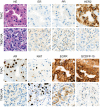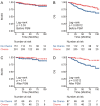Triple-Negative Apocrine Breast Carcinoma Has Better Prognosis despite Poor Response to Neoadjuvant Chemotherapy
- PMID: 35329934
- PMCID: PMC8949126
- DOI: 10.3390/jcm11061607
Triple-Negative Apocrine Breast Carcinoma Has Better Prognosis despite Poor Response to Neoadjuvant Chemotherapy
Abstract
Apocrine carcinoma is a rare subtype of invasive ductal breast cancer that shows apocrine differentiation and largely triple-negative immunohistology. Triple-negative breast cancers are known to have more aggressive clinical courses. However, unlike most other subtypes, it is reported that triple-negative apocrine carcinoma (TNAC) has a better prognosis. Due to the scarcity of reported studies, our knowledge regarding its clinical behavior, prognosis and response to therapy is very limited. In this study, we retrospectively retrieved 41 triple-negative apocrine carcinoma cases from our breast cancer database, with an average follow-up of 32.8 months. It was found that TNAC had a poorer response to neoadjuvant therapy but a better prognosis than other nonapocrine types of triple-negative breast cancer. Meanwhile, TNAC has a low proliferative nature, as indicated by its low Ki-67 index. An updated analysis of the Surveillance, Epidemiology, and End Results database showed that chemotherapy did not improve breast-cancer-specific survival in TNAC patients. Our results suggest that TNAC is a special subtype of triple-negative breast cancer with a better short-term prognosis despite poor response to neoadjuvant chemotherapy.
Keywords: androgen receptor; invasive apocrine carcinoma; neoadjuvant therapy; triple-negative breast cancer.
Conflict of interest statement
The authors declare no competing interest.
Figures




Similar articles
-
Prognosis in triple-negative apocrine carcinomas of the breast: A population-based study.Cancer Med. 2019 Dec;8(18):7523-7531. doi: 10.1002/cam4.2634. Epub 2019 Oct 23. Cancer Med. 2019. PMID: 31642210 Free PMC article.
-
Avoidance and Period-Shortening of Neoadjuvant Chemotherapy Against Triple-Negative Breast Cancer in Stages I and II: Importance of Ki-67 Labeling Index and the Recognition of Apocrine-Type Lesions.Technol Cancer Res Treat. 2020 Jan-Dec;19:1533033820943246. doi: 10.1177/1533033820943246. Technol Cancer Res Treat. 2020. PMID: 32677589 Free PMC article.
-
Triple-negative apocrine carcinoma: A rare pathologic subtype with a better prognosis than other triple-negative breast cancers.J Surg Oncol. 2020 Nov;122(6):1232-1239. doi: 10.1002/jso.26129. Epub 2020 Jul 15. J Surg Oncol. 2020. PMID: 32668059 Free PMC article.
-
Triple-negative apocrine carcinoma as a rare cause of a breast lump in a Syrian female: a case report and review of the literature.BMC Womens Health. 2021 Nov 25;21(1):396. doi: 10.1186/s12905-021-01539-3. BMC Womens Health. 2021. PMID: 34823507 Free PMC article. Review.
-
Rare subtypes of triple negative breast cancer: Current understanding and future directions.NPJ Breast Cancer. 2023 Jun 23;9(1):55. doi: 10.1038/s41523-023-00554-x. NPJ Breast Cancer. 2023. PMID: 37353557 Free PMC article. Review.
Cited by
-
Failure to progress: breast and prostate cancer cell lines in developing targeted therapies.Cancer Metastasis Rev. 2024 Dec;43(4):1529-1548. doi: 10.1007/s10555-024-10202-w. Epub 2024 Jul 26. Cancer Metastasis Rev. 2024. PMID: 39060878 Review.
-
Biomarker Alteration after Neoadjuvant Endocrine Therapy or Chemotherapy in Estrogen Receptor-Positive Breast Cancer.Life (Basel). 2022 Dec 27;13(1):74. doi: 10.3390/life13010074. Life (Basel). 2022. PMID: 36676023 Free PMC article.
-
Clinico-pathological factors predicting pathological response in early triple-negative breast cancer.NPJ Breast Cancer. 2025 Feb 13;11(1):15. doi: 10.1038/s41523-025-00729-8. NPJ Breast Cancer. 2025. PMID: 39948122 Free PMC article.
-
Diagnosis, Prognosis, and Treatment of Triple-Negative Breast Cancer: A Review.Breast Cancer (Dove Med Press). 2025 Mar 17;17:265-274. doi: 10.2147/BCTT.S516542. eCollection 2025. Breast Cancer (Dove Med Press). 2025. PMID: 40124876 Free PMC article. Review.
-
Clinicopathological significance of androgen receptor expression and tumor infiltrating lymphocytes in triple-negative breast cancer: a retrospective cohort study.Breast Cancer. 2025 Mar;32(2):357-368. doi: 10.1007/s12282-024-01662-7. Epub 2024 Dec 27. Breast Cancer. 2025. PMID: 39729292
References
-
- Vranic S., Marchio C., Castellano I., Botta C., Scalzo M.S., Bender R.P., Payan-Gomez C., di Cantogno L.V., Gugliotta P., Tondat F., et al. Immunohistochemical and molecular profiling of histologically defined apocrine carcinomas of the breast. Hum. Pathol. 2015;46:1350–1359. doi: 10.1016/j.humpath.2015.05.017. - DOI - PubMed
-
- Vera-Badillo F.E., Templeton A.J., de Gouveia P., Diaz-Padilla I., Bedard P.L., Al-Mubarak M., Seruga B., Tannock I.F., Ocana A., Amir E. Androgen receptor expression and outcomes in early breast cancer: A systematic review and meta-analysis. J. Natl. Cancer Inst. 2014;106:djt319. doi: 10.1093/jnci/djt319. - DOI - PubMed
Grants and funding
LinkOut - more resources
Full Text Sources

